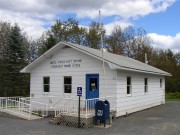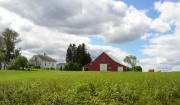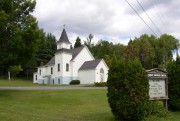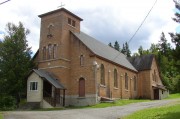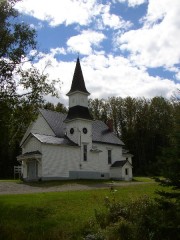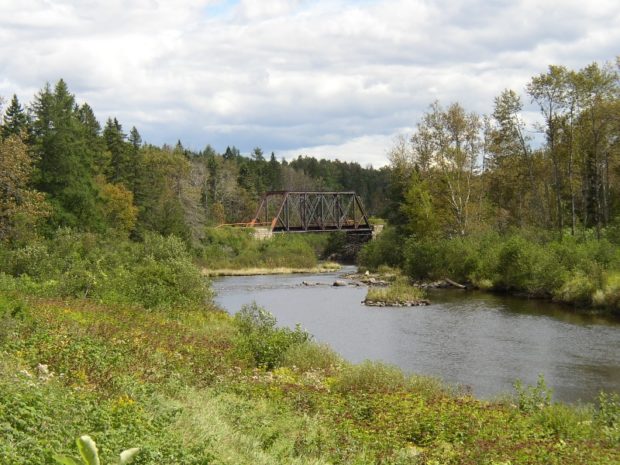

| Year | Population |
|---|---|
| 1970 | 388 |
| 1980 | 319 |
| 1990 | 286 |
| 2000 | 271 |
| 2010 | 253 |
| Geographic Data | |
|---|---|
| N. Latitude | 44:04:08 |
| W. Longitude | 68:07:27 |
| Maine House | District 148 |
| Maine Senate | District 1 |
| Congress | District 2 |
| Area sq. mi. | (total) 34.7 |
| Area sq. mi. | (land) 34.6 |
| Population/sq.mi. | (land) 7.3 |
County: Aroostook
Total=land+water; Land=land only |
|
[STOCK-home] is a town in Aroostook County, organized as a plantation on March 4, 1895 from the township T16 R3 WELS, and incorporated as a town on February 27, 1911. It is located on Bangor & Aroostook (B&A) railroad line.
The first settlers were Alfred and Brita Swenson and Anna and Johannes Anderson who immigrated from Sweden on April 1, 1881 as part of the state’s “Swedish Colony” program.
Stockholm’s Historical Society maintains local records and other materials documenting the town’s development.
Named for the Swedish capital, the village lies on the Little Madawaska River, just off Maine Route 161 and just north of New Sweden, also part of the Colony.
The village, essentially off the main highways, is not “on-the-way” to anywhere.
This small community, with a continued significant reliance on agriculture and a declining population, still supports three churches:
Catholic, Baptist, and Lutheran.
Form of Government: Town Meeting-Select Board-Manager.
Additional resources
Chassé, Marc. Interviews with Maurice Sandstrom and Fred Anderson, Stockholm, Maine. [moving image recording] Fort Kent, Me. Marc Chassé. 2007. [University of Maine at Fort Kent, Blake Library]
Melvin, Charlotte Lenentine. The Swedish People in Northern Maine. 1950. (Thesis (Honors in History)–University of Maine at Orono, 1950) [University of Maine, Raymond H. Fogler Library, Special Collections; University of Maine at Presque Isle, Library and Learning Resource Center]
Old Maine Swedish Farms [film]. Crown of Maine Productions, Inc. http://www.crownofmaineproductions.com/swedfarms.html (accessed April 5, 2012)
Silver Birches: Preserving Cultural Heritage by Learning from Earlier Generations. New Sweden, Me. [published by residents of New Sweden, Stockholm, and Westmanland, Maine] 1981. [University of Maine, Raymond H. Fogler Library, Special Collections; University of Maine at Farmington, Mantor Library]
Stadig, Rita B. Rita Stadig Collection, 1900-2009. (Cataloger Note: A variety of papers and photographs pertaining to the Stadig family and the history of the St. John Valley. The materials cover topics such as the lumber industry, Sweden and the Swedish colony of Aroostook County, World War II and the Fish River; Fort Kent, Wallagrass, and Madawaska are also represented by items in the collection.) [University of Maine at Fort Kent, Blake Library]
Stockholm Centennial Booklet Committee. (Me.) Stockholm Centennial Historical Booklet: 1881-1981. Stockholm, Me. Stockholm Historical Society, c1981. [University of Maine, Raymond H. Fogler Library, Special Collections; University of Maine at Presque Isle, Library and Learning Resource Center]
Town of Stockholm, Maine, 90th anniversary, 1881-1971. Stockholm, Me. 1971? [University of Maine, Raymond H. Fogler Library, Special Collections; University of Maine at Presque Isle, Library and Learning Resource Center]
See additional resources at New Sweden.
National Register of Historic Places – Listings
Anderson Bros. Store
[280 Main Street] Built in 1901, remodeled and enlarged some years later, the Anderson Bros. Store is a common two-story frame building that was the first general store Stockholm. It is the only remaining historic store in the village center. In November 1900 John and Lewis Anderson moved from the adjoining town of New Sweden to Stockholm where they established the community’s first general store. They erected a 20′ x 20′ building, and opened their store in 1901. The impetus for their business venture is related to the fact that Stockholm Plantation (the town was incorporated in 1911) was undergoing a development boom, a direct result of the construction of the Bangor & Aroostook Railroad in 1899 and the establishment of a long lumber mill. This growth is especially evident in the rapid population increase, which rose from 66 persons in 1890 to 715 in 1910.
By then, it appears that the Anderson Bros, partnership had dissolved, but a hardware store operated by Lewis Anderson continued until 1927; it was operated thereafter by A. E. Baxter until 1938-39. George D. Fogelin returned the business to a general store that remained in operation until the late 1950s. In 1976 the property was acquired by the newly formed Stockholm Historical Society [see photo above] which maintains it as a museum.
Little remains of the historic industrial and commercial enterprises that illustrate Stockholm’s rapid development in the early 20h century. So, the Anderson Bros. Store is an especially important reminder of the town’s commercial history.
Source: United States. Department of the Interior. National Park Service. https://npgallery.nps.gov/pdfhost/docs/nrhp/text/00001635.PDF (accessed March 9, 2017)
Sodergren, John J. and Martha, Homestead
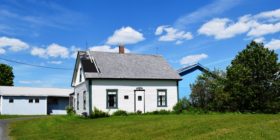 The Sodergren Farm was settled in 1884 by the Sodergren family, who, like many Swedes in the decade before them, had immigrated to the Swedish. The farm contains a little altered, but modest, one-story log house set on a slight knoll and surrounded by fields that the family has tended for almost 125 years.
The Sodergren Farm was settled in 1884 by the Sodergren family, who, like many Swedes in the decade before them, had immigrated to the Swedish. The farm contains a little altered, but modest, one-story log house set on a slight knoll and surrounded by fields that the family has tended for almost 125 years.
Jons Sodergren came from Undersaker, Sweden in 1879. He and his wife and youngest son Peter settled on the North Jemtland Road near the Stockholm border. They sent a ticket for daughter Brita, who arrived with her husband, Alfred Swenson. They settled a lot that Peter had reserved, the first farm in Stockholm.
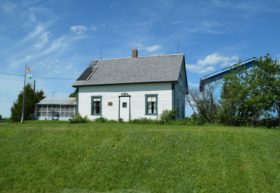 Eventually Jons and Margreta Sodergren brought over the remainder of their children, Paul, Olaf and John J. Sodergren, who with his wife Martha (Jonson) landed in Portland on April 24, 1884, on their way to Stockholm. After arriving in Stockholm they stayed in the cabin of Nils Wiks, and John J. started to clear the adjacent homestead that they had picked out. In the fall of that year they moved into their log house.
Eventually Jons and Margreta Sodergren brought over the remainder of their children, Paul, Olaf and John J. Sodergren, who with his wife Martha (Jonson) landed in Portland on April 24, 1884, on their way to Stockholm. After arriving in Stockholm they stayed in the cabin of Nils Wiks, and John J. started to clear the adjacent homestead that they had picked out. In the fall of that year they moved into their log house.
Each successive Sodergren generation has lived in the log house, including the family of John August and Lena Sodergren, and the family of John and Elna Sodergren, who lived in the log house with their children until 1973. Each of the generations has farmed the land that has included crops of wheat, potatoes, and apples, as well as pigs, chickens and other livestock. The first barn burned in 1930 but was quickly rebuilt. Since about 1967 the land had been hayed and pastured, but most other agricultural activities have ceased. The second barn burned about 1977. Nonetheless, due to the diligence of the Sodergren family, the fields remain open and fertile, which compliments the historic value of the log house.
Source: United States. Department of the Interior. National Park Service. https://npgallery.nps.gov/pdfhost/docs/nrhp/text/00001635.PDF (accessed March 9, 2017)
Sunset Lodge
[ .5 miles South of Maine Route 161, on Madawaska Lake, eastern shore, apparently demolished based on a visit to the site.]

Sunset Lodge was a cedar log camp built in 1932 on the shore of Madawaska Lake. Built by Presque Isle mill operator Bruce Ward as a summer camp, the second log building built by the Ward Lumber Company, which specialized log cabins. Bruce Robert Ward (1876-1944) was born in St. Francis. After graduation from the Madawaska Training (High) School, he worked for the Great Northern Paper Company and the Fort Kent Mill Company, a manufacturer of sawn lumber.
About 1917 he established a general store and sawmill in St. Francis under the name “Ward and Bradbury.” He briefly operated another mill in Washburn before moving to Presque Isle where he founded the Northern Cedar Company in 1927. His business initially focussed on the production of peeled cedar logs for telephone and electric power poles as well as pile structures. An excess of stock led him to the idea of further milling the logs on one side and assembling them into buildings. The first one built by the company the American Legion Hall in Yarmouth, built in 1931. The logs and assistance in building were donated by the Northern Cedar Company.
The following spring Ward built his cabin at Madawaska Lake. Throughout the 1930s and up to the United States’ entry into World War II, the firm apparently had steadily increased its production of material for log cabins. Shipments were made to several states including New Jersey, Wisconsin, and Rhode Island, the last of which included the site of thirty cabins on Bonnet Shores in Narragansett, built for a Mr. Bodwell of the Belton Corporation. In 1935 Ward apparetly began advertising in several outdoor magazines. About this time he developed a tongue and groove method of joining the individual logs together and an interlocking system of corner joining. This refinement of the manufacturing technique was a significant departure from the method used at Sunset Lodge, in which oakum was used to seal the joints. It also substantially altered the appearance of the prototype, particularly in the exterior finish where the unequally sized logs and variety in the corner joining presents a more rustic configuration to the more standardized elements.
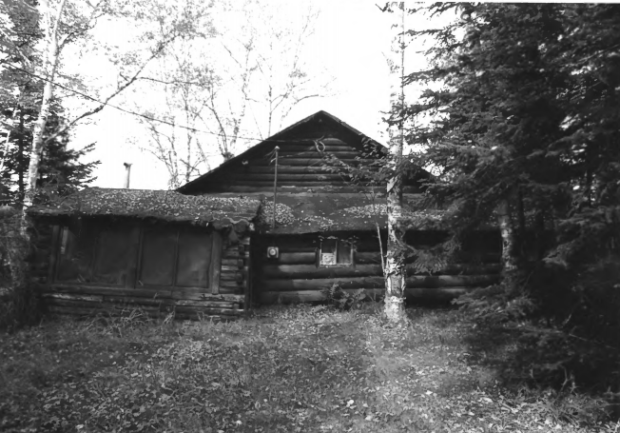
Two houses that Ward built in Presque Isle for his family show this progression in design. After Bruce Ward’s death, in 1944 the family sold most of the company to local businessmen who relocated it to Houlton in 1957 and operated it until 1964 when fire destroyed most of the plant. The company was acquired and rebuilt by the McLaughlin family who marketed their product under the name Ward Log Homes and claimed to be the oldest manufacturer of log houses in the country.
Round log houses have a long history of use in Maine, undoubtedly extending to the very early years of settlement. They served as temporary shelters until more permanent houses could be built. In the 19th century, the tradition of log construction was continued in deep woods logging camps. By the time of the country’s Centennial celebration in 1876, the romantic notion of the pioneer log cabin had assumed a wide appeal. In late 19th century Maine, the tradition of log building continued in the growing inland tourist industry where most sporting camps adopted this style for camps and out-buildings. The early 20th century saw the further versions in road-side tourist cabins that catered to automobile travelers. At the same time, log buildings became a popular alternative for individually owned or leased sites along Maine’s countless lakes. In time they would also become viable alternatives for year-round housing. Sunset Lodge and Bruce Ward’s role in the development of Maine’s log building industry are significant parts of the history of early 20th century housing in Maine.
[Kirk F. Mohney photos for Maine Historic Preservation Commission, 1994]



